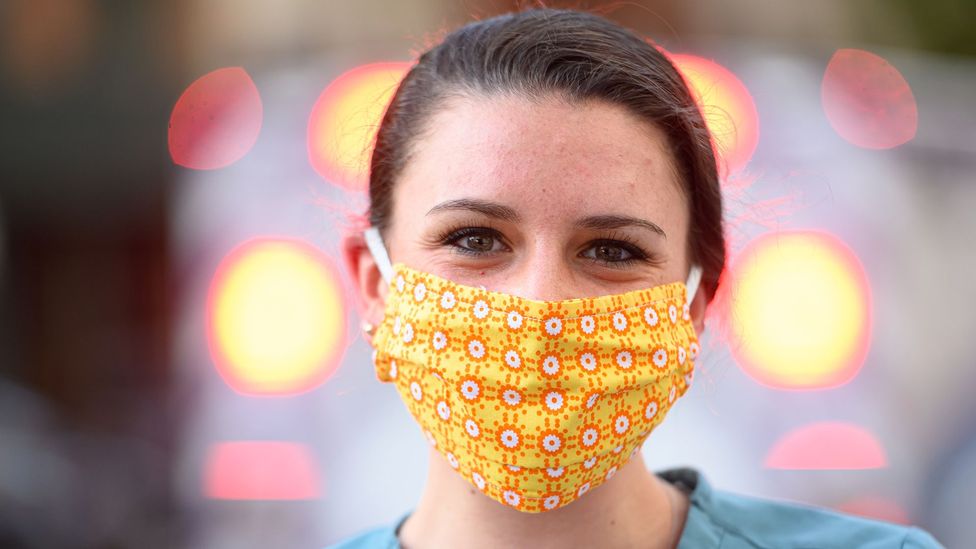
Face masks are a symbol of the pandemic era – a visual metaphor for the tiny, unseen viral foe that could be lurking around any corner.
Some opt for a scarf wrapped around their face, others make do with a t-shirt yanked up over their mouth.
The more creative hook colourful homemade varieties around their ears, while a lucky few wear distinctive surgical masks or, rarer still, N95 respirators.
While a few months ago anyone wearing a mask in public would have drawn stares in many countries unused to this behaviour, they are now a reminder of the strange times we live in.
And as governments around the world start to ease their lockdowns to allow their citizens out to mingle in the wider world again, growing numbers of people are opting to wear face masks in public.
But there is still debate about whether members of the public should be encouraged to wear face masks at all.
In the early days of the pandemic, many governments warned the public against wearing face masks for fear demand would leave frontline health workers without vital supplies and that it may lull people into a false sense of security.
Some – such as the US – have since reversed that advice. The state of Utah has said it will provide a free face mask to any citizen who requests it.
And other countries such as the Czech Republic, Slovakia, Austria, Morocco, Turkey and Germany have all made wearing masks in public mandatory.
It is likely others will follow their lead as they ease restrictions.
But can face masks really make a difference in our battle against Covid-19?
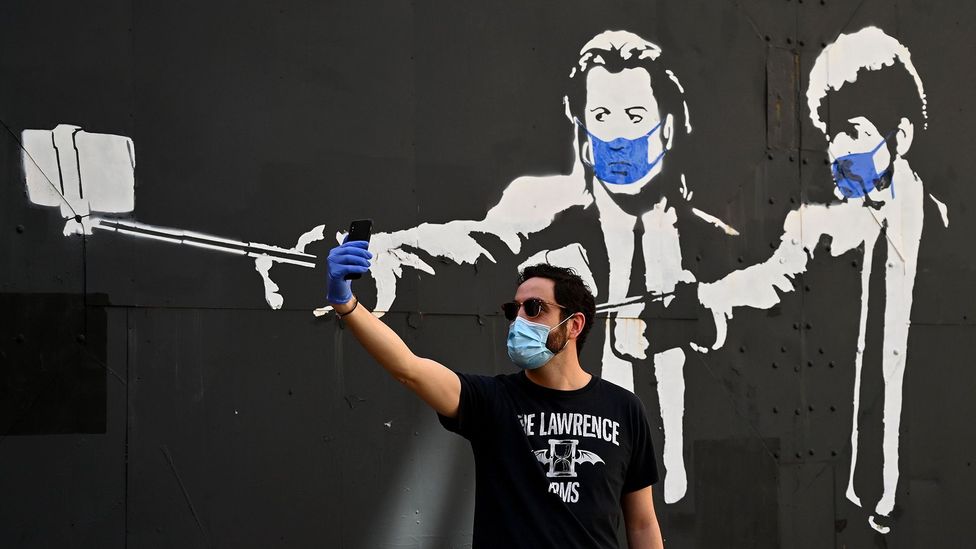
Face masks are likely to become a common part of life when out in public as lockdowns start to be lifted (Credit: Getty Images)
“A key point is that the countries that flattened the curve used masks in public,” says Chris Kenyon, head of the sexually transmitted diseases unit at The Institute of Tropical Medicine in Antwerp, who has examined whether face masks may have played a role in limiting the spread of Covid-19 in certain countries.
“These were mostly Asian countries. For some reason, until very recently European experts – Czechia (Czech Republic) excluded – were unable to learn from what worked in Asia.”
To understand why face masks might work, it is important to look at how the virus that causes Covid-19 spreads in the first place.
Once it has infected someone, the Sars-CoV-2 virus responsible for the disease hijacks their cells to replicate itself.
As it multiplies, these new virus particles then burst out of the cells and become suspended in the bodily fluids in our lungs, mouth and nose.
When an infected person coughs, they can send showers of tiny droplets – known as aerosols – filled with the virus into the air.
A single cough can produce up to 3,000 droplets.
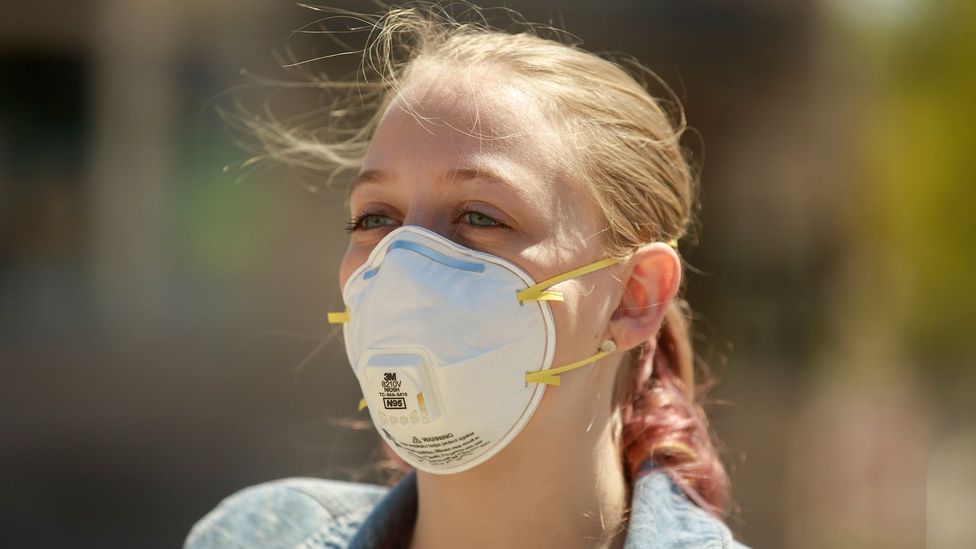
While the N95 respirator mask offers a high level of protection, most health officials believe it should be prioritised for frontline health workers (Credit: Getty Images)
There are fears the virus can also be spread simply through speaking. One recent study showed that we spray thousands of droplets invisible to the naked eye into the air just by uttering the words “stay healthy”.
Once out of our mouths, many of the larger droplets will quickly settle onto nearby surfaces while smaller ones remain suspended in the air for hours, where they can be breathed in.
While the behaviour of the virus-filled droplets in rooms with air conditioning and outside environments are less well understood, they are thought to settle on surfaces more quickly in disturbed air.
There are also some reports that the coronavirus can spread through ventilation systems in buildings.
(Read more about how long coronavirus survives on surfaces.)The Sars-CoV-2 virus has been found to survive in these aerosol droplets for at least three hours,
according to one study by virologist Neeltje van Doremalen and her colleagues at the US National Institute of Allergy and Infectious Diseases, Hamilton, Montana. But a more recent, but as yet unpublished study, has found that the Sars-CoV-2 virus is still infectious for more than 16 hours after being suspended in aerosol droplets.
It found the virus was “remarkably resilient in aerosol form” compared to other similar coronaviruses they studied.
Together, they suggest that in the right conditions, the virus can linger in the air for several hours and still infect people if breathed in. And in indoor environments, they seem to be particularly prone to spreading through the air.
An unpublished analysis of 318 outbreaks of Covid-19 in China showed that it was most commonly transmitted in indoor environments, particularly in people’s homes, but also on public transport, in restaurants, cinemas and shops.
They found just one example where the virus appeared to have been transmitted while people were outside.
Genetic material from Sars-CoV-2 has also been detected in the air in toilets and rooms used by people infected with Covid-19.
One study of a cluster of cases that occured in a restaurant in Guangzhou, China, suggests that in poorly ventilated spaces the virus can spread to people sitting in the immediate vicinity through airborne aerosol droplets.
“Face masks could help to reduce transmission in the community particularly if used in public transport and crowded areas,” says Ben Cowling, head of epidemiology and biostatistics at the University of Hong Kong.
He and his colleagues recently published a study looking at the effectiveness of face masks to prevent the spread of the virus from infected people.
They found a standard surgical face mask was enough to considerably reduce the amount of virus escaping in the breath and coughs of people infected with different respiratory viruses, including a mild type of coronavirus, influenza and a rhinovirus that causes the common cold.
“One of the proposals for lifting lockdowns is that we use mass testing along with contact tracing and quarantine, to get ahead of infections in the community,” says Cowling.
“If you are identified as an infected person, the health department can trace your family members, your social contacts and your occupational contacts, but it is very difficult to trace who you were sitting next to on the bus or train.
“If we can limit transmission in these kinds of locations, it could really be a big help.”
One of the reasons widespread, public face mask wearing is so important with Covid-19 has to do with the prevalence of asymptomatic carriers who can still spread the virus to others.
It is estimated that anywhere from 6% to almost 18% of those infected can carry the virus without developing symptoms.
Add to this an incubation period of around five days, but up to 14 days in some cases, before symptoms develop and even those who do go on to show signs of being contagious can spread the virus to a lot of people before they start to fall ill.
“This makes it particularly difficult to suppress transmission in the community,” says Cowling.
“But if everybody is wearing face masks, that would mean infected and asymptomatic people are also wearing masks. That could help to reduce the amount of virus which gets into the environment and potentially causes infections.”
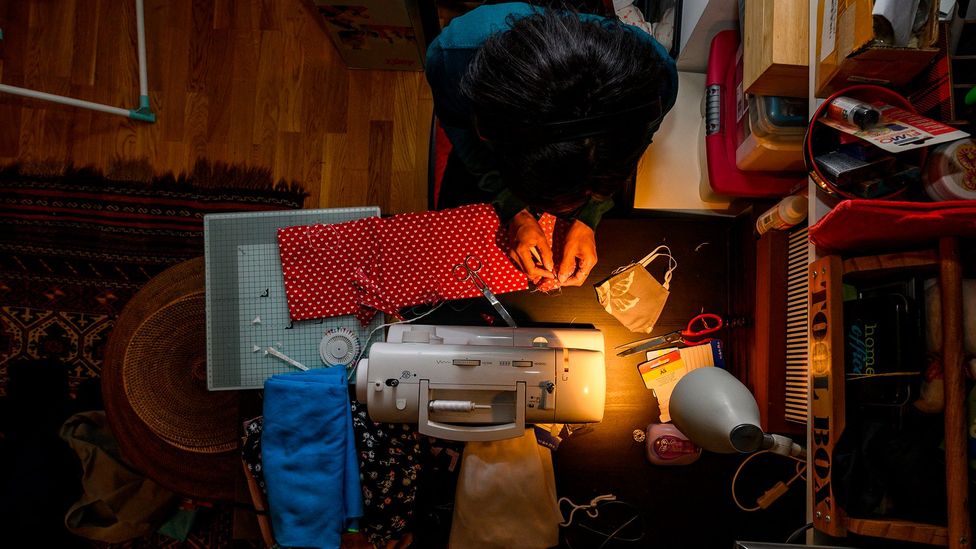 With a shortage of face masks, many people are turning to their sewing machines to make their own (Credit: Getty Images)
With a shortage of face masks, many people are turning to their sewing machines to make their own (Credit: Getty Images)
Even wearing a damp homemade mask can reduce the number of droplets each of us emit while we speak, according to a study by researchers at the US National Institutes of Health, Bethesda, Maryland.
So, while face masks might help those already carrying the virus from passing it to others, can they also protect the uninfected from breathing it in?
Certainly the ability of specialised, disposable masks like the N95 respirator and the equivalent FFP-2 respirator mask in Europe to filter out particles from the air is high.
They are designed to passively filter out 95% and 94% of airborne particles respectively – down to the size of 0.3 micrometres across – as the wearer breathes.
Their performance with blocking viruses from entering, however, is more mixed.
Some viruses can be as small as 0.01 micrometres, while researchers have reported the coronavirus that causes Covid-19 is 0.07-0.09 micrometres in size.
Respiratory viruses, however, tend to be suspended in aerosol droplets, which can range in size from 0.1-900 micrometres, so blocking these is often more important.
Some older studies have suggested that smaller viruses than might be expected can slip through the N95 filter, but they have been found to be effective at blocking the influenza virus.
And there is some research to suggest these respirator masks are effective when it comes to protecting people against Covid-19.
One analysis of health workers in China showed that those who wore N95 respirators did not become infected with the virus, despite caring for highly-contagious patients. This is one of the reasons why these masks have been deemed so important for frontline healthcare workers.
The concern is that, if the general public buy up all of the already short supplies of these masks, it will leave these crucial workers, who are the most likely to be exposed, unprotected and vulnerable.
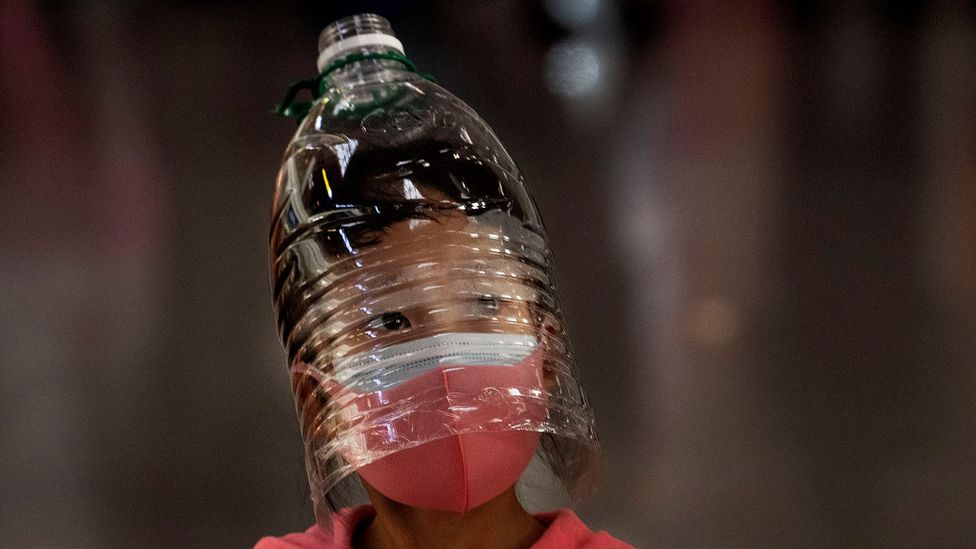 Some homemade masks are more successful than others at protecting the wearer from coronavirus (Credit: Getty Images)
Some homemade masks are more successful than others at protecting the wearer from coronavirus (Credit: Getty Images)
The World Health Organization has urged the general public not to wear these masks in order to secure supplies for health workers, and this has also been the rationale behind the reluctance of many governments to encourage the public to wear masks.
There are also some who fear that face masks can induce a false sense of security in those who wear them. One recent unpublished study from researchers at Yale University suggests that in US states where madates have been introduced for face mask wearing in public, people appear to be spending 20-30 minutes less time at home and make more visits to commercial locations such as shops following the change in the rules.
While there is now some evidence that respirator masks can be disinfected for reuse, it is far from a perfect solution.
“We really need to ensure we have sufficient supplies of facemasks for healthcare workers,” adds Cowling.
Such is the shortage of Personal Protective Equipment (PPE) like N95 respirator masks, that some scientists have investigated building alternatives from materials that can be found lying around in hospitals.
Another potential issue with asking the public to wear these masks is that they require training to fit properly.
If they are not correctly fitted, the seal around the mouth and nose can still allow viral particles to slip around the side.
Facial hair can also affect their performance as it disrupts the seal.
The US Centers for Disease Control and Protection (CDC) has published a helpful guide for anyone sporting facial hair and looking to wear face masks – a neat “soul patch”, a pencil moustache or Zappa-style trim should be fine. Those sporting designer stubble, a flamboyant Dali or full Garibaldi might need to consider a shave.
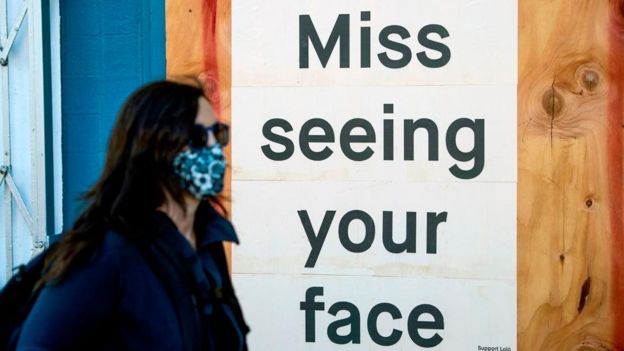
With everyone wearing masks it will become harder to pick up on the subtle communication from facial expressions (Credit: Getty Images)
But there are simpler alternatives available too. One recent, but yet to be peer-reviewed, study found a 3M surgical mask – the kind worn by surgeons in operating theatres – could keep out almost 75% of particles down to a size of 0.02 micrometres.
While far less effective than an N95 respirator, a surgical mask can still help to reduce the number of particles breathed in.
But by cutting a hole in the end of a stocking and wearing that over the mask, it was possible to improve the mask’s ability to cut out particles to 90%.
“Surgical masks, unlike N95 respirators, are designed to fit loosely,” says Loretta Fernandez, an environmental chemist at Northeastern University, in Boston, Massachusetts, who was one of those involved in the study.
“This allows some air to go around the mask to the breathing zone rather than through the mask material.” They found that the addition of “nylons” on the outside of the mask helped to reduce this.
But with demand for surgical masks also high, many members of the public are being forced to make their own alternatives. There are already a wide range of designs available online for do-it-yourself mask makers, with most using cotton fabric to create a pocket that a filter of some kind can be placed in. Some suggest using vacuum cleaner bags, others add coffee filters between two bandanas or insert folded pillow cases.
Yang Wang, an environmental engineer at Missouri University of Science and Technology, and one of his students built a few examples of these masks and found that using fabrics with a higher thread count worked better. A cotton bandana was the least effective, followed by a woolen scarf, but a 600-thread-count pillowcase folded four times could filter out around 60% of the particles.
Masks made from allergy-reducing air conditioning filters and vacuum cleaner bags were found to work best, almost matching the performance of an N95 respirator.
“There is a lot of potential for fabric masks and particularly masks which incorporate non-woven materials like those used in some dust mops,” says Cowling. “There is no reason why surgical masks should be the ‘best’ type of masks to wear in the community, but some fabrics have too many ‘holes’ and would not perform well.”
Fernandez and her collaborator Amy Mueller, an engineer at Northeastern University, also examined the effectiveness of different homemade masks.
The most effective used multiple fabric layers, although they fell some way short of N95 and surgical masks. Adding a nylon on top to clinch the mask onto the face, however, did increase the effectiveness to the point where some homemade designs were able to keep out 80% of the particles.
Other researchers have found that while pulling a t-shirt up over your nose and mouth will block less than half of the aerosols coming towards it, doubling and even tripling the layers of a cotton t-shirt fabric can dramatically improve things in an emergency. Other fabrics such as silk and polyester were also found to be surprisingly effective. Cotton flannel, felted wool and quilting cotton have been found to be particularly good at blocking ultrafine particles, and one study suggested that a single sock, when flat and pressed tightly against the nose and mouth, could also serve as a good emergency mask substitute.
Much like the disposable N95 and surgical masks, homemade varieties like these are really only good for one use before they need to be disinfected if you want to maximise their potential. The US CDC recommends routinely washing homemade masks. Hot water alone may not be enough – one recent study found the Sars-CoV-2 virus can survive temperatures of at least 60C. Fortunately, the oily envelope that encases coronaviruses can be pulled part by soap and household detergent.
But Mueller warns that all these alternatives cannot be seen as replacements for an N95 mask.
“There is a very important question – for health officials to interpret from the data that we are collecting – about what level of particle filtration is ‘safe enough’? It is unfortunate but true that in some cases people may be choosing between multiple imperfect options.”
But even with these imperfect options, wearing them in public could make a difference by helping to keep infection rates down as people come out of lockdown and start mingling again. For example, researchers at University College London have warned that the pavements in the UK’s busiest city, much like many others around the world, may not be wide enough to allow people to maintain a safe distance from each other. In confined spaces, such as on public transport, it is even harder.
Tests on homemade masks have shown they can still significantly reduce the spread of other viral infections such as influenza. They can also help to reduce the dispersal of the virus onto nearby surfaces when people cough.
Provided enough people wear masks when venturing out in public, it could have a dramatic impact on how quickly the coronavirus starts to spread again, particularly if combined with other measures such as social distancing and handwashing.
One unpublished study by scientists at Arizona State University found that if 80% of people wore only moderately effective masks, it could reduce the number of deaths in New York by 17-45% over a two month period.
Even wearing masks that were just 20% effective could cut mortality by 24-65% in Washington and 2-9% in New York, if enough people wore them.
In countries where masks are in short supply, some researchers have suggested that prioritising them for the elderly could also be effective.
While face masks might bring a little discomfort, and make it harder to spot the facial expressions of those we are talking to, those things are a small price to pay for keeping the people around us safe and well.
Mục lục
Đeo khẩu trang có thực sự giảm lây Covid-19?
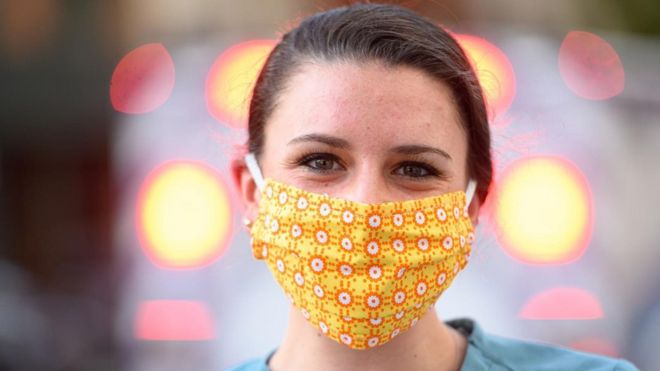 GETTY IMAGES
GETTY IMAGES
Khẩu trang là một biểu tượng của thời đại dịch – một phép ẩn dụ trực quan đại diện cho kẻ thù siêu nhỏ, vô hình có thể đang ẩn nấp ở bất kỳ ngóc ngách nào.
Một số người dùng cách lấy khăn quàng cổ quấn quanh mặt, trong khi những người khác tự biến tấu với một chiếc áo phông kéo lên che miệng.
Những khẩu trang sáng tạo hơn có chỗ mắc nhiều thứ sặc sỡ tự làm xung quanh lỗ tai, trong khi một số ít may mắn đeo khẩu trang phẫu thuật đặc trưng hoặc, hiếm hơn nữa, khẩu trang N95.
Tranh cãi về khẩu trang
Trong khi một vài tháng trước, bất cứ ai đeo khẩu trang nơi công cộng có thể sẽ thu hút những cái nhìn chằm chặp ở nhiều quốc gia không quen với việc này, thì giờ đây khẩu trang là lời nhắc nhở về thời kỳ kỳ lạ mà chúng ta đang sống.
Và khi các chính phủ trên thế giới bắt đầu nới lỏng phong tỏa để cho phép người dân hòa nhập trở lại vào xã hội, ngày càng có nhiều người đeo khẩu trang khi ra ngoài.
Nhưng vẫn còn tranh cãi liệu có nên khuyến khích công chúng đeo khẩu trang hay không.
Trong những ngày đầu đại dịch, nhiều chính phủ cảnh báo công chúng không nên đeo khẩu trang vì sợ nhu cầu tăng vọt sẽ khiến nhân viên y tế tuyến đầu thiếu hụt trang thiết bị thiết yếu và điều đó có thể ru ngủ người dân vào cảm giác an toàn giả tạo.
Một số nước – chẳng hạn Mỹ – đã quay ngoắt lại lập trường. Tiểu bang Utah cho biết họ sẽ cung cấp một khẩu trang miễn phí cho bất kỳ người dân nào yêu cầu.
Và các nước khác như Cộng hòa Séc, Slovakia, Áo, Ma-rốc, Thổ Nhĩ Kỳ và Đức đều bắt buộc đeo khẩu trang nơi công cộng.
Có khả năng những nước khác sẽ làm theo những nước này khi họ nới lỏng các hạn chế.
Nhưng liệu khẩu trang có thực sự tạo ra khác biệt trong trận chiến với Covid-19?
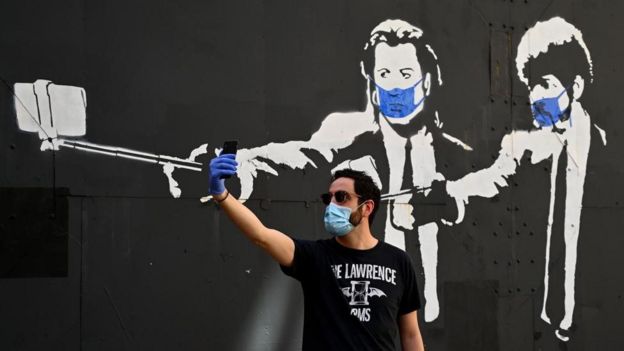 GETTY IMAGES Khẩu trang có khả năng trở thành một phần phổ biến của cuộc sống khi ra ngoài nơi công cộng khi phong tỏa bắt đầu được dỡ bỏ
GETTY IMAGES Khẩu trang có khả năng trở thành một phần phổ biến của cuộc sống khi ra ngoài nơi công cộng khi phong tỏa bắt đầu được dỡ bỏ“Một điểm mấu chốt là các quốc gia kéo thẳng đường đồ thị lây nhiễm đều buộc đeo khẩu trang ở nơi công cộng,” Chris Kenyon, trưởng khoa bệnh lây truyền qua đường tình dục tại Viện Y học Nhiệt đới ở Antwerp, vốn đã nghiên cứu liệu khẩu trang có vai trò gì không trong hạn chế sự lây lan của Covid-19 ở một số quốc gia, nói.
“Hầu hết đây là các nước châu Á. Vì một số lý do nào đó, cho đến gần đây các chuyên gia châu Âu – trừ Cộng hòa Séc – không thể học hỏi được gì từ những điều có tác dụng chống dịch ở châu Á.”
Tồn tại trong không khí
Để hiểu tại sao khẩu trang có hiệu quả, điều quan trọng là phải xem xét cách thức virus gây bệnh Covid-19 lây lan ngay từ gốc.
Một khi virus xâm nhập vào ai đó, virus Sars-CoV-2 gây ra bệnh Covid-19 chiếm quyền điều khiển các tế bào để nhân lên.
Khi chúng nhân lên, những virus mới này sau đó bung ra khỏi tế bào và nằm lơ lửng trong chất dịch cơ thể ở trong phổi, miệng và mũi.
Khi một người nhiễm bệnh ho ra, họ có thể bắn ra cơn mưa những giọt rớt nhỏ li ti – vốn được gọi là khí dung – chứa đầy virus vào không khí.
Chỉ một cái ho có thể tạo ra tới 3.000 giọt bắn.
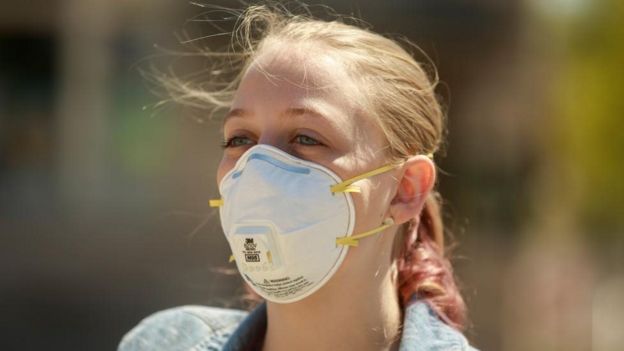 GETTY IMAGES
GETTY IMAGESMặc dù mặt nạ lọc hơi thở vào N95 mang lại mức độ bảo vệ cao, nhưng hầu hết các quan chức y tế tin rằng nó nên được ưu tiên cho nhân viên y tế tuyến đầu (Tín dụng: Getty Images)
Có những lo ngại virus cũng có thể lây lan chỉ bằng cách nói chuyện. Một nghiên cứu gần đây cho thấy chúng ta xả vào không trung hàng ngàn giọt bắn mà mắt thường không nhìn thấy được chỉ bằng cách thốt ra những câu: ‘stay healthy’ (giữ gìn sức khỏe).
Một khi bay ra khỏi miệng chúng ta, nhiều giọt bắn lớn sẽ nhanh chóng rơi xuống các bề mặt gần đó trong khi những giọt nhỏ hơn vẫn lơ lửng trong không khí hàng giờ và sẽ có người hít vào.
Mặc dù những giọt bắn có chứa đầy virus này hoạt động như thế nào trong phòng có điều hòa cũng như ngoài trời vẫn chưa được hiểu kỹ càng, nhưng chúng được cho là sẽ rớt xuống các bề mặt nhanh hơn trong môi trường không khí bị xáo động.
Cũng có một số báo cáo cho rằng virus corona có thể lây lan qua hệ thống thông gió trong các tòa nhà.
Theo một nghiên cứu của nhà virus học Neeltje van Doremalen và các đồng nghiệp của bà tại Viện Dị ứng và Bệnh truyền nhiễm Quốc gia Hoa Kỳ ở Hamilton, bang Montana, virus Sars-CoV-2 được tìm thấy sống sót trong những giọt bắn khí dung này trong ít nhất ba tiếng đồng hồ.
Nhưng một nghiên cứu mới đây hơn và vẫn chưa được công bố đã phát hiện ra rằng virus Sars-CoV-2 vẫn có khả năng lây nhiễm trong hơn 16 tiếng khi lơ lửng trong các giọt bắn khí dung.
Nghiên cứu này phát hiện ra virus này ‘có sự dẻo dai đáng kinh ngạc ở dạng khí dung’ so với các loại virus corona tương tự khác mà họ đã nghiên cứu.
Các nhà nghiên cứu cùng nhau cho rằng trong điều kiện thích hợp, virus có thể lảng vảng trong không khí trong nhiều giờ và vẫn lây nhiễm cho con người nếu hít vào. Và trong môi trường trong nhà, chúng dường như đặc biệt dễ lây lan qua không khí.
Một phân tích chưa được công bố về 318 ổ dịch Covid-19 ở Trung Quốc cho thấy nó lây lan thường xuyên nhất trong môi trường trong nhà, đặc biệt là trong nhà của người dân, và trên các phương tiện giao thông công cộng, trong nhà hàng, rạp chiếu bóng và cửa hàng.
Họ chỉ tìm thấy một trường hợp virus dường như đã lây lan khi mọi người ở ngoài đường.
Chất liệu di truyền của Sars-CoV-2 cũng đã được phát hiện trong không khí trong nhà vệ sinh và các căn phòng mà người nhiễm Covid-19 sử dụng qua.
Một nghiên cứu về một chùm các ca nhiễm ở một nhà hàng ở Quảng Châu, Trung Quốc, cho thấy trong những không gian được thông khí kém, virus có thể lây sang những người ngồi gần nhau thông qua các giọt bắn khí dung.
Ca nhiễm không triệu chứng
“Khẩu trang có thể giảm lây lan trong cộng đồng, nhất là trong hệ thống giao thông công cộng và các khu vực đông đúc,” ông Ben Cowling, trưởng bộ phận dịch tễ học và thống kê sinh học tại Đại học Hong Kong, nói.
Ông và các đồng sự mới đây đã công bố một nghiên cứu về tính hiệu quả của khẩu trang trong việc ngăn chặn sự lây lan của virus từ người nhiễm bệnh.
Họ phát hiện rằng khẩu trang phẫu thuật tiêu chuẩn là đủ để giảm đáng kể lượng virus thoát ra trong hơi thở và cơn ho của những người bị nhiễm các loại virus đường hô hấp khác nhau, bao gồm một loại virus corona thể nhẹ, cúm và loại vi trùng gây cảm lạnh thông thường.
“Một trong những đề xuất để dỡ phong tỏa là áp dụng xét nghiệm quy mô lớn cùng với truy dấu tiếp xúc và cách ly, để vượt qua sự lây nhiễm trùng trong cộng đồng,” Cowling nói.
“Nếu bạn được xác định là nhiễm virus, cơ quan y tế có thể truy ra những người thân, các mối liên hệ xã hội và quan hệ nghề nghiệp của bạn, nhưng rất khó để truy ra bạn đã ngồi cạnh ai trên xe buýt hay tàu điện.”
“Nếu chúng ta có thể hạn chế lây nhiễm ở những chỗ này, thì thật sự sẽ rất có ích.”
Một trong những lý do việc đeo khẩu trang rộng rãi nơi công cộng rất quan trọng trong chống dịch Covid-19 là sự hiện diện rộng rãi của những người nhiễm bệnh không có triệu chứng vốn vẫn có thể truyền virus cho người khác.
Người ta ước tính rằng có khoảng từ 6% cho đến gần 18% những người nhiễm virus có thể mang virus mà không có triệu chứng.
Thêm vào đó là thời gian ủ bệnh khoảng năm ngày, nhưng trong một số trường hợp có thể lên đến 14 ngày, trước khi xuất hiện các triệu chứng. Ngay cả những người có dấu hiệu lây nhiễm có thể đã lây bệnh cho nhiều người trước khi họ bắt đầu ngã bệnh.
“Điều này làm cho việc chặn đứng lây nhiễm trong cộng đồng đặc biệt khó khăn,” Cowling nói.
“Nhưng nếu tất cả mọi người đều đeo khẩu trang, tức là những người đã bị nhiễm và không có triệu chứng cũng đeo khẩu trang, điều đó có thể giúp giảm lượng virus xâm nhập vào môi trường và có khả năng lây nhiễm.”
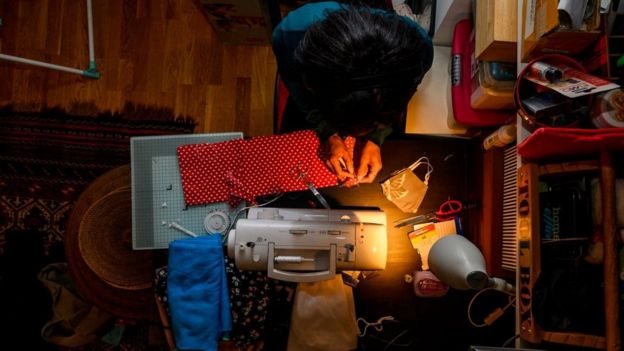 GETTY IMAGES Khi thiếu mặt nạ, nhiều người đang quay sang dùng máy may để tự làm
GETTY IMAGES Khi thiếu mặt nạ, nhiều người đang quay sang dùng máy may để tự làmNgay cả đeo khẩu trang tự chế cũng có thể làm giảm số lượng giọt bắn mà mỗi người chúng ta xả ra khi nói chuyện, theo một nghiên cứu của các nhà khoa học tại Viện Y tế Quốc gia Mỹ ở Bethesda, bang Maryland.
Có ngăn virus xâm nhập không?
Vậy thì, nếu như khẩu trang có thể giúp ngăn người có virus lây cho người khác, thì liệu nó cũng có thể giúp cho người không bị nhiễm không hít vào virus hay không?
Chắc chắn khả năng lọc các hạt trong không khí của khẩu trang chuyên dụng, dùng một lần như khẩu trang N95 và khẩu trang phòng độc FFP-2 tương đương ở châu Âu là rất cao.
Chúng được thiết kế để lọc thụ động các hạt trong không khí tương ứng là 95% và 94% – tới các hạt có kích thước nhỏ đến 0,3 micro mét – khi người đeo hít thở.
Tuy nhiên, hiệu suất của các loại khẩu trang này trong việc ngăn chặn virus xâm nhập vào cơ thể lại không rõ ràng.
Một số virus có thể nhỏ tới 0,01 micromet, trong khi các nhà nghiên cứu đã cho biết virus corona gây bệnh Covid-19 có kích thước 0,07-0,09 micromet.
Tuy nhiên, các virus hô hấp có xu hướng lơ lửng trong các giọt bắn khí dung, có thể có kích thước từ 0,1 cho đến 900 micromet, do đó, chặn những virus này thường quan trọng hơn.
Một số nghiên cứu trước đây đã cho rằng các vi trùng nhỏ hơn chúng ta nghĩ có thể lọt qua bộ lọc của khẩu trang N95, nhưng chúng đã được chứng minh là có hiệu quả trong việc ngăn chặn virus cúm.
Có một số nghiên cứu cho thấy những khẩu trang này có tác dụng trong việc bảo vệ mọi người trước Covid-19.
Một phân tích trên các nhân viên y tế ở Trung Quốc cho thấy những người đeo khẩu trang N95 không bị nhiễm virus, mặc dù họ chăm sóc cho những bệnh nhân cực kỳ dễ lây. Đây là một trong những lý do tại sao những chiếc khẩu trang này được coi là tối quan trọng đối với các nhân viên y tế tuyến đầu.
Điều quan ngại là, nếu công chúng mua tất cả nguồn khẩu trang vốn đã bị thiếu hụt này, nó sẽ khiến những nhân viên y tế thiết yếu, những người có khả năng nhất bị phơi nhiễm, không được bảo vệ và dễ bị tổn thương.
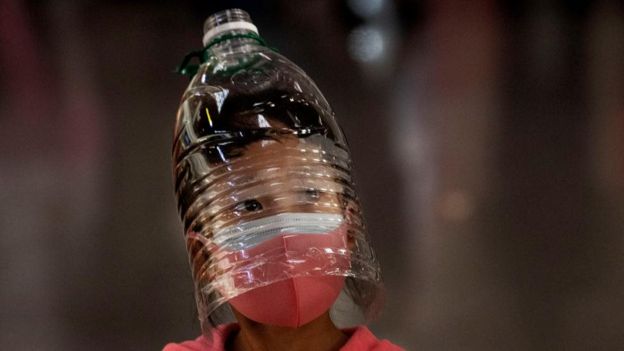 GETTY IMAGES Một số mặt nạ tự chế thành công hơn những số khác trong việc bảo vệ người đeo không bị nhiễm coronavirus
GETTY IMAGES Một số mặt nạ tự chế thành công hơn những số khác trong việc bảo vệ người đeo không bị nhiễm coronavirusTổ chức Y tế Thế giới đã kêu gọi công chúng không nên đeo khẩu trang để đảm bảo nguồn cung cho nhân viên y tế, và đây cũng là nguyên do tại sao nhiều chính phủ trên thế giới miễn cưỡng không muốn khuyến khích công chúng đeo khẩu trang.
Đeo cho đúng
Mặc dù hiện nay có một số bằng chứng cho thấy khẩu trang phòng độc có thể được khử trùng để tái sử dụng, nhưng đó không phải là giải pháp hoàn hảo.
“Chúng ta thực sự cần phải đảm bảo có đủ nguồn cung khẩu trang cho các nhân viên y tế,” Cowling nói thêm.
Chính sự thiếu hụt Thiết bị Bảo hộ Cá nhân (PPE) như khẩu trang N95 đã khiến một số nhà khoa học tìm cách xây dựng phương án thay thế từ những vật liệu có thể tìm thấy trong bệnh viện.
Một vấn đề khác của việc yêu cầu công chúng đeo khẩu trang là cần phải hướng dẫn cách đeo cho đúng.
Nếu khẩu trang không được đeo đúng cách, chỗ khép quanh miệng và mũi vẫn có thể để cho virus lách vào ở mé bên.
Râu ria cũng có thể ảnh hưởng đến hiệu quả của khẩu trang vì nó làm cho khẩu trang không khép chặt lại.
Trung tâm Kiểm soát Dịch bệnh Mỹ (CDC) đã công bố hướng dẫn hữu ích cho bất kỳ ai có râu ria muốn đeo khẩu trang.
 GETTY IMAGES Khi tất cả mọi người đeo mặt nạ, sự giao tiếp tinh tế từ nét mặtsẽ trở nên khó khăn hơn để thu nhận
GETTY IMAGES Khi tất cả mọi người đeo mặt nạ, sự giao tiếp tinh tế từ nét mặtsẽ trở nên khó khăn hơn để thu nhận
Nhưng cũng có những lựa chọn thay thế đơn giản hơn. Một nghiên cứu gần đây, nhưng chưa được đánh giá đồng đẳng, đã phát hiện ra khẩu trang phẫu thuật 3M – loại bác sĩ phẫu thuật đeo trong phòng mổ – có thể loại bỏ gần 75% các hạt có kích thước đến 0,02 micromet.
Mặc dù kém công hiệu hơn nhiều so với khẩu trang N95, khẩu trang phẫu thuật vẫn có thể giúp giảm số lượng hạt hít vào.
Nhưng bằng cách cắt một lỗ ở gót chiếc vớ và đeo nó lên khẩu trang có thể cải thiện khả năng của khẩu trang và lọc được đến 90% các hạt.
“Khẩu trang phẫu thuật, không giống như khẩu trang phòng độc N95, được thiết kế để vừa lên mặt một cách lỏng lẻo,” bà Loretta Fernandez, nhà hóa học môi trường tại Đại học Đông Bắc, Boston, Massachusetts, một trong những người tham gia vào nghiên cứu này, cho biết.
“Điều này cho phép không khí tìm đường xung quanh khẩu trang để đến vùng thở hơn là đi thẳng qua khẩu trang.” Họ phát hiện ra rằng việc bổ sung thêm nylon ở mặt ngoài khẩu trang đã làm giảm việc này.
Fernandez và cộng tác viên Amy Mueller, kỹ sư tại Đại học Đông Bắc, cũng đã xem xét tính hiệu quả của các khẩu trang tự chế khác nhau.
Loại công hiệu nhất dùng nhiều lớp vải, mặc dù vẫn không công hiệu bằng khẩu trang N95 và khẩu trang phẫu thuật.
Tuy nhiên, thêm một lớp nylon ở trên để cho khẩu trang bám lên mặt làm tăng hiệu quả đến mức mà một số khẩu trang tự chế có thể ngăn được 80% các hạt.
Lọc bao nhiêu là đủ?
Giống như N95 dùng một lần và khẩu trang phẫu thuật, các loại khẩu trang tự chế như thế này thực sự chỉ tốt cho một lần sử dụng và sau đó chúng cần được khử trùng nếu muốn phát huy tối đa tiềm năng.
CDC khuyến cáo nên thường xuyên giặt khẩu trang tự chế. Nước nóng thôi có thể là không đủ – một nghiên cứu gần đây cho thấy Sars-CoV-2 có thể tồn tại ở nhiệt độ ít nhất là 60 độ C. May mắn là lớp màng nhầy bao quanh virus corona có thể được kéo vỡ bằng xà phòng và bột giặt.
Nhưng Mueller cảnh báo rằng tất cả các lựa chọn thay thế này không thể được xem có thể thay thế cho khẩu trang N95.
“Có một câu hỏi rất quan trọng – để giới chức y tế giải thích từ dữ liệu mà chúng ta đang thu thập – về mức độ lọc như thế nào là ‘đủ an toàn’? Thật đáng tiếc nhưng đúng là trong một số trường hợp chúng ta phải chọn lựa giữa nhiều lựa chọn không hoàn hảo.”
Các thử nghiệm trên khẩu trang tự chế cho thấy chúng có thể làm giảm đáng kể sự lây lan của các virus khác như cúm. Chúng cũng có thể giúp giảm sự phát tán của virus lên các bề mặt gần đó khi mọi người ho.
Giả sử có đủ số người đeo khẩu trang khi đi ra ngoài nơi công cộng, việc này có thể có tác động rất lớn đến việc virus corona bắt đầu lây lan trở lại nhanh như thế nào, nhất là khi kết hợp với các biện pháp khác như xa cách xã hội và rửa tay.
Một nghiên cứu chưa được công bố của các nhà khoa học tại Đại học Bang Arizona cho thấy nếu 80% người dân chỉ đeo khẩu trang có hiệu quả vừa phải, số người chết ở New York có thể giảm 17-45% trong khoảng thời gian hai tháng.
Ngay cả đeo loại khẩu trang chỉ có hiệu quả 20% cũng có thể giảm tỷ lệ tử vong 24-65% ở Washington và 2-9% ở New York, nếu có đủ người đeo.
